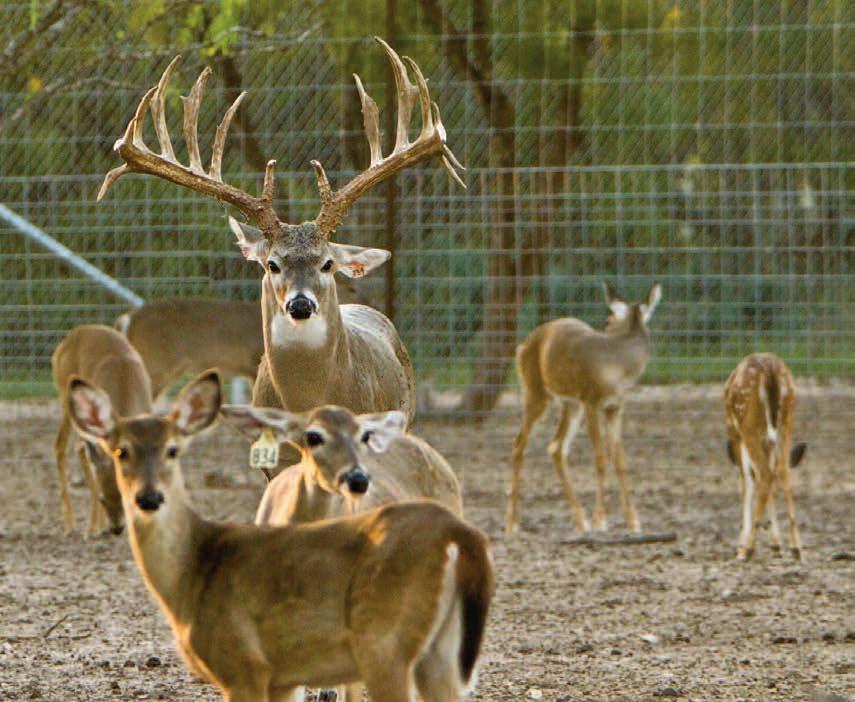
3 minute read
Nutrition of Fawns: Birth to Weaning
By Michael L. Schlegel PhD, PAS, Dipl. ACAS-nutrition Sr. Nutritionist, Wildlife and Small Ruminant Technical Innovation Purina Animal Nutrition LLC
Newborn fawns represent the start of a new generation, genetic improvement, and the future. Since there has been an investment in the doe and the buck, it is important to get fawns off to a positive start to see that return. The nutrition of fawns starts with the doe even before fawns are born during the last third of pregnancy and continues and through lactation. Two additional items to a successful fawn program include colostrum consumption and getting fawns started on feed.
Advertisement
The greatest amount of fawn fetal growth rate occurs during the last third of pregnancy with approximately 67% of the birth weight gained during this period. Does that are malnourished during the last third of pregnancy will have fawns that are smaller and weigh less than if they received an adequate plane of nutrition. After fawns are born, one of the most critical management practices is to ensure that fawns consume colostrum within the first 24-36 hours after birth to provide passive immunity (the transfer of antibodies from the doe to the fawn). Fawns will typically nurse 36 minutes after birth. If a doe rejects a fawn, colostrum replacers can be used to provide antibodies, but nothing is better than the doe’s colostrum. Fawns with greater immunoglobulins (antibodies) at 24 hours after birth had greater survivability than those that did not survive. Lack of colostrum consumption and failure of passive immunity in deer and livestock can increase the newborn animal’s susceptibility to septicemia, diarrhea, other disease, and increase risk of mortality.
As one would expect, does with a 20% decrease in food resources during lactation had fawns with lower growth rates during the first 30 days post-fawning. If the doe produces inadequate amounts of milk or rejects the fawn, an appropriate milk replacer should be used to feed the fawn. In a breeding facility, this is also a good time to consult the herd veterinarian to ensure appropriate vaccines and other health procedures are completed.
Fawns begin nibbling on dry feed starting at two weeks of age. In deer breeding facilities, this is a good time to provide a fawn diet in a creep area that is only accessible to fawns. The fawn diet should be palatable to attract the fawns to the creep area and be kept fresh. It is also ideal for the fawn diet to be similar to the adult diet to allow an easy transition at weaning time. The goal is to provide supplemental energy and nutrients to the fawn in excess to what the doe can provide through the milk. The creep area should be an area out of the weather with clean dry bedding and, fresh-clean water. The fawn diet should be fed through weaning and slowly replaced with the adult diet during the weaning process.
By ensuring does are fed appropriately during late gestation and lactation and fawns receive colostrum and get started on dry feed, fawns will have a successful beginning. Providing optimal nutrition early in life will support fawn growth, body condition and fawns will more likely express their genetic potential for antler growth, reproduction and have productive futures.
Dr. Schlegel received his B.S. in Animal Production from The Pennsylvania State University and a M.S. and Ph.D. in Ruminant Nutrition from the Department of Animal Science at Michigan State University. He completed a joint postdoctoral research fellowship with the University of Florida’s Department of Animal Science and Disney’s Animal Kingdom Animal Programs in exotic animal nutrition. Dr. Schlegel is a Certified Professional Animal Scientist and a Diplomat of the American College of Animal Sciences –Nutrition Discipline. He taught in the Department of Animal Science as an Assistant Professor at Delaware Valley University (Doylestown, Pennsylvania). Dr. Schlegel was the Director of Nutritional Services at San Diego Zoo Global from 2005 to 2015. Dr. Schlegel joined Purina Animal Nutrition as a Senior Nutritionist in November of 2015 and is part of the Technical Innovation team focusing on wildlife and small ruminants. Dr. Schlegel is a member of the Comparative Nutrition Society, American Society of Animal Science, and American Registry of Professional Animal Scientists. He has been a section editor for the Journal of Zoo and Wildlife Medicine, and has authored numerous peer-reviewed articles, book chapters, proceedings, abstracts and research reports.





